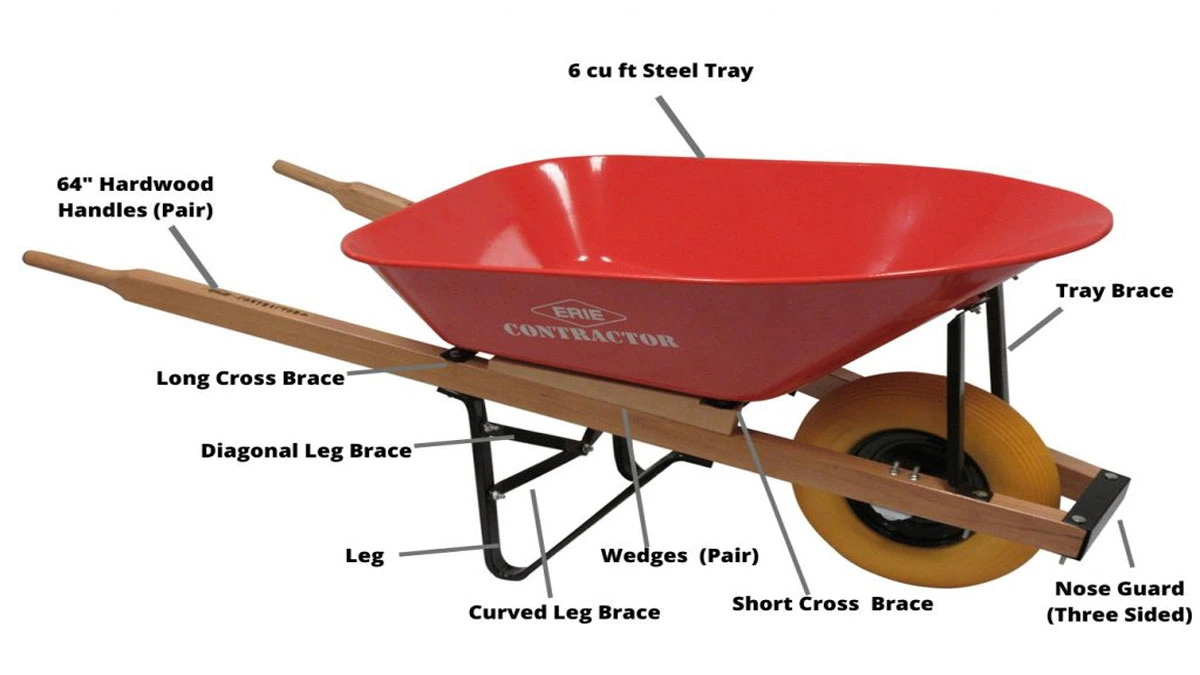Table of Contents
A wheelbarrow is a straightforward device that has been employed for moving products from one place to another for ages. A high-quality wheelbarrow is useful because it makes it simpler to transfer heavy items, especially in places where other modes of transportation, like vehicles, are impractical. This article will delve into the various parts of the wheelbarrow its basic design, underlying principles, and crucial components.

Principal
A wheelbarrow works on the basis that it employs a lever to lessen the effort needed to lift and transport large items. A wheelbarrow’s fundamental components include handles, a tray or bucket to hold the weight and a wheel.
The wheelbarrow is hoisted by the handles after the load has been placed in the tray. Next, the load is balanced on the wheel before being propelled forward. The wheelbarrow operates according to the rule of levers.
This law states that a tiny force applied to one end of a lever can result in a huge force being delivered to the opposite end of the lever. The wheelbarrow’s handles, fulcrum, and load all refer to the weight that is being transported. The leverage the handles offer reduces the amount of force needed to lift the item.
Design
A wheelbarrow is a simple yet effective tool for transporting materials and goods. It consists of a frame, handles, a bucket or tray, a wheel, an axle, braces, and a leg. The frame is made of metal or wood and is shaped like a “U” or rectangle, with two legs at the back and one leg at the front.
The handles are comfortable and angled upward, allowing for easy lifting and pushing. The bucket or tray holds the load, and the wheel and axle are located at the front for smooth maneuvering.
Braces are metal rods that distribute the load evenly across the frame and provide additional support for the bucket or tray. The leg, located at the front, helps maintain stability and prevent tipping over. Overall, the wheelbarrow is a versatile and efficient tool for transporting materials and goods.

Parts of the wheelbarrow
Parts
Wheel
Trays
Handles
Front brace
Leg brace
Axel bucket
Bearing
Wheel
The component of the wheelbarrow that rolls on the ground is the wheel. It is often attached to the axle and made of metal or plastic. Depending on how the wheelbarrow will be used, the wheel size may change.
While a smaller wheel is simpler to control on flat ground, a larger wheel is better suited for irregular terrain. In order to balance the load and give it stability, the wheel is typically positioned in the middle of the tray or bucket.
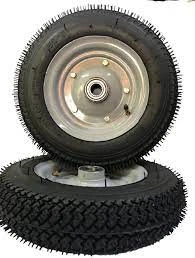
For example, a wheelbarrow used for gardening may have a smaller, pneumatic wheel that can better handle uneven terrain, while a wheelbarrow used for construction may have a larger, solid wheel that can better handle heavier loads.
Pneumatic
Pneumatic tires are popular on wheelbarrows, because they offer traction and comfort, are lightweight, and are portable. However, they can have flat surfaces, especially on unpaved surfaces.
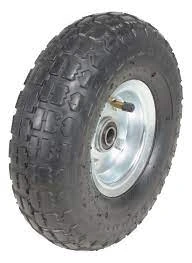
Semi-pneumatic
Semi-pneumatic tires combine pneumatic and solid tires, offering cushioning without flat-tire risk and better handling in difficult terrain. Although they may cost more and be less lightweight, they offer advantages over pneumatic tires, such as less monitoring and no need for inflating.
Non-pneumatic
Semi-pneumatic tires are a hybrid of pneumatic and solid tires, without air tubes, ensuring stability. Non-pneumatic tires are durable, and rough terrain-ready, but they lack cushioning and maneuverability.

Tray
A wheelbarrow tray, also known as a bin, is the part of the wheelbarrow that holds the load. It is usually made of metal, plastic, or wood and is attached to the frame of the wheelbarrow. The size and shape of the tray can vary depending on the wheelbarrow’s intended use.
For example, a wheelbarrow used for gardening may have a shallow tray that is designed to hold light loads, while a wheelbarrow used for construction may have a deep tray that is designed to hold heavy loads.
Removable tray
The majority of the time, removable trays are constructed of metal and are fastened to the wheelbarrow with bolts or pins. As a result, it is simple to take the frame apart for cleaning or storing.
Advantage
Simple to remove for cleaning
If damaged, it is replaceable
can be modified to meet particular demands
Disadvantage
it might cost more than permanent frames
More difficult to assemble and disassemble
Can be more prone to damage
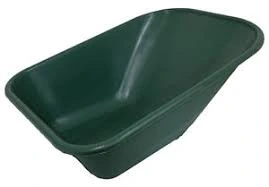
Permanent tray
Fixed trays are non-removable and frequently constructed of molded plastic or metal that has been welded. Permanent trays are more typical on heavy-duty wheelbarrows used in demanding applications like construction.
Advantage
stronger than moveable frames
cheaper than frames that can be removed
easier to put together and take apart
less vulnerable to harm
Disadvantage
can’t be removed for cleaning
Damage that can’t be repaired
cannot be modified to meet certain needs
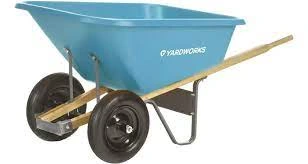
Handle
The wheelbarrow handle is the part the user holds onto to push or pull the load. It typically has two parallel handles attached to the tray or bucket, made of metal or wood and padded for comfort.
The handles’ length and shape vary depending on their intended use, with longer handles providing more leverage and shorter ones for tight spaces.
They are connected to the tray or bucket via braces, providing stability and preventing shifting or spilling. Some wheelbarrows also have adjustable handles for different heights.important of handle

Wood
Wood handles on wheelbarrows offer comfort, and shock absorption, but are vulnerable to water damage and rot.
Metal
Metal handles on heavy-duty wheelbarrows offer durability and reduce water damage, but they may be slippery and cause hand fatigue.
Composite
Composite handles, made from fiberglass and plastic, offer a lightweight, durable, and comfortable grip, but may be more expensive.
Front brace
Front braces are metal bars that connect handles to a tray or bucket, distributing loads evenly and providing stability. They extend upward and backward, depending on the wheelbarrow’s design.
They work with support legs to maintain stability and prevent tipping over. Front braces also add strength and prevent flexing under heavy loads. Some wheelbarrows may have additional reinforcing cross braces for added strength and stability.
Leg brace
Leg braces are metal bars that connect support legs to a tray or bucket, providing stability to a wheelbarrow. They work in conjunction with the front braces to distribute the load evenly and prevent tipping over.
Some wheelbarrows have additional reinforcing cross braces for added strength and stability. Leg braces can be adjusted to accommodate different loads or adjust stability.
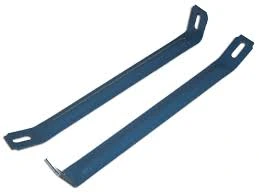
Axel bucket
The wheelbarrow’s axle and bucket are crucial components, ensuring smooth and easy movement and transport of materials and objects.
The axle is a metal rod or shaft, while the bucket is a container for holding the load, typically made of metal or plastic. Together, these components work together to ensure the wheelbarrow’s smooth movement and efficient transportation of materials and objects.
Bearing
Wheelbarrow bearings are small metal components that enable the wheel to rotate smoothly on the axle.
They are typically sealed or unsealed, with sealed bearings being higher-end and maintenance-free. Unsealed bearings are more common in lower-end models and require periodic maintenance to maintain lubrication.
They are less expensive but may need more frequent replacements. The bearings are located on the wheel’s axle, which supports the load and allows the wheel to rotate freely. If worn or damaged, the bearings may cause wobble or difficulty turning, requiring replacement to maintain smooth operation.
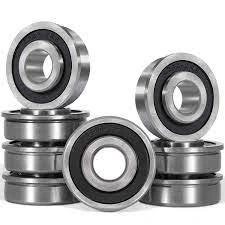
Ball bearing
Ball bearings are widely used in wheelbarrows, consisting of small balls rolling between rings, ensuring efficiency and durability.
Roller bearing
Roller bearings are less common but better suited for heavy loads, consisting of cylindrical rollers between rings, offering durability but a higher cost.
Conclusion
A wheelbarrow is a simple yet effective tool for transporting materials and goods. Its basic design includes handles, a tray, and a wheel, operating on levers. Different types of wheels, trays, and handles are essential for smooth movement and efficient transportation. Understanding these components helps you choose the right one for your needs and ensures proper maintenance and repairs.

